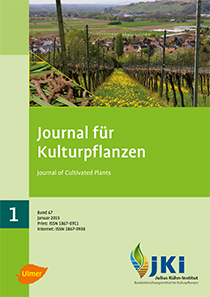Methodological aspects in the collection of earthworm communities in quality viticulture
Keywords:
Validation of methods, biological monitoring, copper-containing pesticides, quality viticulture, copper loads, exposure, earthworm monitoring, bioavailability to soil organisms, bio concentration factor, pathway soil/soil organisms, soil fertilityAbstract
The aim of the project is to describe effects of copper loads on the soil organism communities in vineyards based on current data from surveys of the JKI for loads and exposure (chemical monitoring) of sites considered to have a model character because of their typical site and management characteristics. A toolbox of methods will be further developed in order to assess the impact of copper pollution on earthworms in prestigious vineyards.
The effect of copper on the soil fertility of speciality crops areas is determined under field conditions, using earthworms as indicators, with abundances and biomass as well as abundance distributions of species and their distribution in the ecological groups as assessment parameters. Part of the project is to design a survey of the current situation of the indicator community earthworm conenose taking into account representative aspects. This study combined the biological situation and an extended site and management specific exposures with respect to the elaborated hypotheses on the origin of effects.
Over the period 2010–2014 24 representative sites were included in the survey, each of which has at least one test plot (organic and/or conventional management), a reference plot, which is a plot with older copper loads having been set-aside for a longer time, and a control plot without any anthropogenic copper load.
These studies on the effects of copper levels on soil organisms serve as the scientific basis for benefit-risk assessment of the active ingredient copper in connection with its inclusion in the list of approved active substances provided for in Article 78, paragraph 3 of Regulation 1107/2009/EG.
DOI: 10.5073/JfK.2015.01.01, https://doi.org/10.5073/JfK.2015.01.01
Downloads
Published
Issue
Section
License
The content of the journal is licensed under the Creative Commons Attribution 4.0 License. Any user is free to share and adapt (remix, transform, build upon) the content as long as the original publication is attributed (authors, title, year, journal, issue, pages).
The copyright of the published work remains with the authors. The authors grant the Journal of Cultivated Plants, the Julius Kühn-Institut and the OpenAgrar repository the non-exclusive right to distribute and exploit the work.







